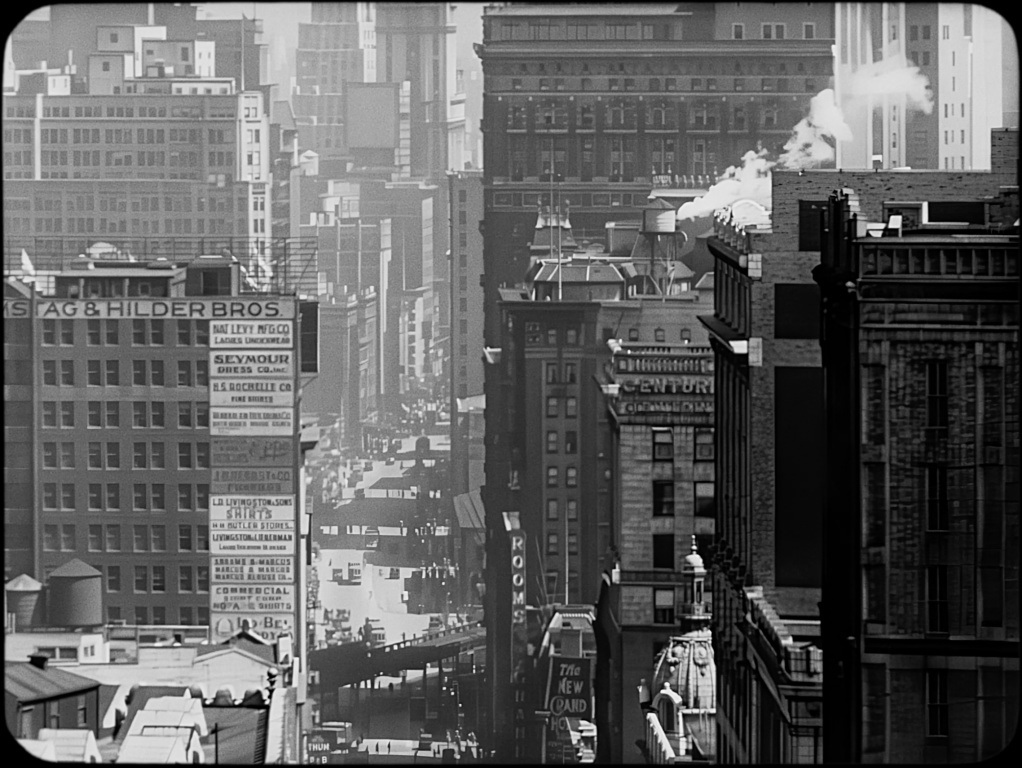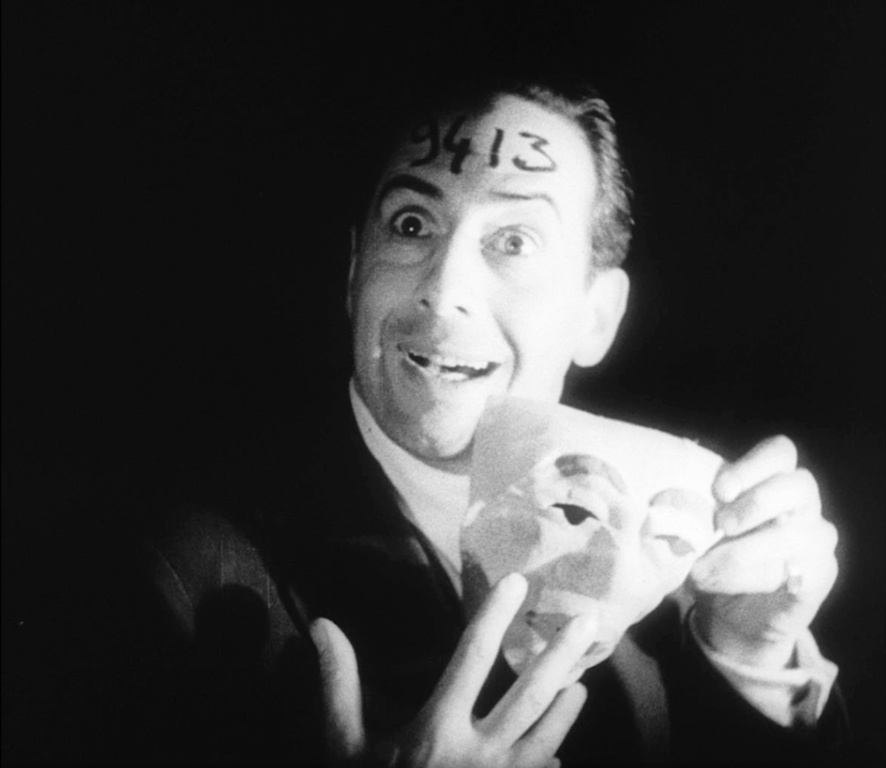21 Experiments with Silent Film & New Music
PRODUCED BY BRUCE POSNER/1922-2022
BLU-RAY STREET DATE: FEBRUARY 21, 2023/KINO CLASSICS

With the Blu-ray release of Silent Avant-Garde, Kino Lorber continues its decades-running devotion to the history of outside-the-mainstream filmmaking. As the disc’s own copy says, this gathering of twenty-one short art film experiments includes digitally restored works by Marcel Duchamp, Man Ray, Orson Welles, Mary Ellen Bute & many more. Per that list, the experienced collector may correctly deduce that many (more than half, actually) of these films have been previously made available by Kino Lorber via its out-of-print Raymond Rohauer Collection DVD sets. For them, the question then becomes whether or not this format upgrade is worthwhile.
Impressively presented in glistening HD from various 5K scans (not 4K- it says 5K! This archival film technology is becoming more and more like a marathon all the time!) made from 35mm and 16mm picture elements, this one-disc set boasts brand new digital restorations of classic experimental films as well as notable portions of work by some of the avant-garde’s most celebrated filmmakers. Some are quite stunning; some are downright beautiful. It’s likely no one will be equally gaga for all twenty-one entries, but none are unworthy of inclusion. (Even the upgrades of previously available films). In this review, we’ll take a closer look at select titles in this very impressive and diverse assortment.
The program, which plays continuously with only very brief numeric graphics to delineate that a piece is about to begin (alternately, the individual films are accessible through a separate menu on the main screen), begins with Robert Flaherty’s incredibly absorbing fourteen-minute film, Twenty-Four Dollar Island (1925). Here Flaherty steps away from the exotic locales of his “docufictions” to turn his lens upon the emerging metropolis that will soon be New York City as we know it. Most everything is shot from afar with the same curiosity and semi-alienation that the filmmaker brings to Nanook of the North (1922), Moana (1926), or Man of Aran (1934). There’s something intoxicating about it. This is advanced all the further by the truly stunning quality of the restoration. Twenty-Four Dollar Island has a crystal clarity about it that never betrays its celluloid origins. It is the single finest individual presentation of the bunch.

Ralph Steiner’s Look Park (1973) is a tight ten-minute montage of mostly water in the titular Massachusetts park. The music by Jacob Druckman and Jacques Offenbach begins as the kind of tranquil, classical overlay that one might expect to pair with such serene nature footage. But Steiner has more on his mind. Although a text overlay at the beginning tells us that there is no manipulation to what we’re seeing, and that anyone could see the same thing if only they look hard enough, that doesn’t remain true. The classical music as well as the color film stock give way to avant-garde droid-like beeping and sounds and fragmented black and white abstract close-ups. In any case, it all about the water. It’s a wonderful piece that springs from Slavko Vorkapich, and freely parlays into experimental sensory images. George Lucas no doubt strongly approves.
Speaking of Slavko Vorkapich, the prolific film artist and educator who, in his time teaching at USC, proved to be a key cinematic influence for both Art Clokey (in the 1950s) and George Lucas (in the 1960s), is the Blu-ray’s foremost artist (with clips five thru eight of the full twenty-one). The catch, if it is to be considered a catch, is that Vorkapich’s four pieces are not any of his tranquil original shorts, but rather a quick collection of his late 1920s/1930s Hollywood optical montage work. You know, those active “on the town!” barrages of lights, signs and newspaper headlines? Creating such in-vogue insert sequences for movies was Vorkapich’s bread and butter back then. Included here are his montage work from the films Manhattan Cocktail (1928), The Wolf of Wall Street (1929), Sins of the Fathers (1928), and Crime Without Passion (1934).

Derek Smith of Slant’s own review of this set seizes on Silent Avant-Garde’s “impulse to defamiliarize the familiar” via its very curation. Smith goes on to note that this impulse is paired tightly with New York City- itself the one-time thriving hub of experimental filmmaking- as an inescapable reoccurring subject throughout the disc’s playlist. I defer to Smith’s summary on the matter wherein he states that the city “plays a central role in Paul Strand and Charles Sheeler’s Manhatta, Robert Flaherty’s Twenty-Four Dollar Island, Jay Leyda’s A Bronx Morning, all of which use the hustle and bustle of the city as a means for visual expression”. Whether actively warped by Francis Thompson (who is said to have spent over two decades concocting unique methods to achieve his transfixingly liquid visuals, never revealing them) in 1957’s N.Y., N.Y. or merely observed from afar ala Robert Flaherty’s aforementioned inclusion, it’s safe to declare that the city had a true hold on early and mid-century film artists.
Another present trope is the notion of “visual music”, an aggressive obsession of geniuses no less seminal than animators Oskar Fischinger, Norman McClaren, and John Whitney, among others. Silent Avant-Garde gives us none of them, instead opting for the equally noteworthy Synchromy No.4 – Escape (1938; here credited simply as “Escape”) by Mary Ellen Bute and Ted Nemeth, a four-plus-minute animated fusion of classical music (Toccata in D Minor by J.S. Bach) and morphing shapes. Today, it’s retro-cool, sure, but it’s also the kind of thing that we’d quickly equate to a screensaver, albeit rendered in the limited analog rust-and-mint hues of two-strip Technicolor.
(A related aside…) The very notion of “visual music”, as pursued by the above-mentioned pioneers, is something I’ve grappled with on and off over the years. I’m talking about the notion (as I’ve understood it) to be a complete synthesis of music and the motion picture, resulting in a transcendent third form wherein the amalgam is such that it is its own thing. As noted, genius multimedia artists across the twentieth century far smarter than I pursued this notion in their work, often obsessively.
To me, I can’t get away from the notion that no matter how far one pushes it, or how effectively one manages to merge music and image, it’s still just, at best, really really really accomplished editing/assembly. I’ve viewed the pursuit of “visual music” as a “fountain of youth”-level pursuit by very smart artists who frustrated themselves by (in their stated opinions) never getting there but created lots of groundbreaking and quite fascinating art along the way. John Whitney, for one, invented his way into a form of computer graphics that helped pave the way for Pixar and the like. But in his old age, he still expressed lament that his notion of visual music eluded him. But I digress. If Escape, in the context of this Blu-ray collection, signifies anything, it’s that transcendence lies not only in the eye of the beholder, but can be nullified over time by something as mechanical as technological advancement.

Finally, there’s the matter of musician credits. The copy tells us that “each film features a brilliant accompaniment of original silent film music specially prepared, composed, improvised and/or performed by a master of experimental new music”. The choices, whether dictated by the filmmakers or newly interpreted and created, are beyond functional. All the composers and conductors and whatnot are credited onscreen at the very beginning and then at the very end of the entire program, but nowhere could I find a handy published list that pairs the films with their musicians, so I’ve gone ahead and done that. Also noted are which films have undergone brand new digital restorations. Below is the complete list of Silent Avant-Garde titles, which span from 1922 to 2022 (favoring the 1920s and 1930s) and collectively run a healthy 188 minutes:
1. TWENTY-FOUR DOLLAR ISLAND (1925), 14 min. Brand new digital restoration. Music by Donald Sosin
2. EISENSTEIN MEXICAN FOOTAGE (1930), 5 min. Brand new digital restoration. No music
3. ANÉMIC CINÉMA (1926), 7 min. Music by Gustavo Matamoros
4. PAS DE DEUX (1924), 4 min. Music by Donald Sosin
5-6-7-8. VORKAPICH MONTAGE SEQUENCES (1928-1934), 5 min. Music by John Alden Carpenter (5-6-7.); Ludwig van Beethoven (8.)
9. A BRONX MORNING (1931), 14 min. Music by Donald Sosin
10. LOOK PARK (1973), 10 min. Brand new digital restoration. Music by Jacob Druckman, Jacques Offenbach
11. LIFE AND DEATH OF 9413 (1927), 14 min. Music by Carlos Dominguez, Alex Lough 12. HÄNDE (1927), 13 min. Music by Marc Blitzstein
13. RETURN TO REASON (1923), 2 min. Brand new digital restoration. Music by George Antheil, performed by Guy Livingston; Paul Lehrman
14. MANHATTA (1921), 12 min. Music by Donald Sosin
15. BALLET MECHANIQUE (1924, 1931), 13 min. Brand new digital restoration. Music by George Antheil, Charles Amirkhanian
16. HEARTS OF AGE (1934), 8 min. Music by Donald Sosin
17. ESCAPE (1938), 4 min. Brand new digital restoration. Music by Johann Sebastian Bach, conducted by Léopold Stokowski
18. N.Y., N.Y. (1949-1958), 15 min. Music by Gene Forrell
19. THE ECLIPSE aka ROSE HOBART (1936-1949), 21 min. Brand new digital restoration. Music by Rafael Audinot, Alberto de Bru, Cuarteto Caney
20. TENGA FE (1906, 1922, 2022), 7 min. Brand new digital restoration. Music by Christian Wolff
21. THE ENCHANTED CITY (1922), 12 min. Brand new digital restoration. Music by Donald Sosin

